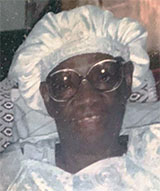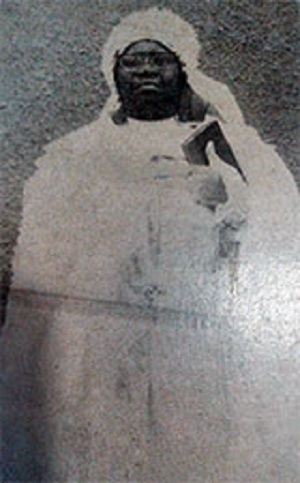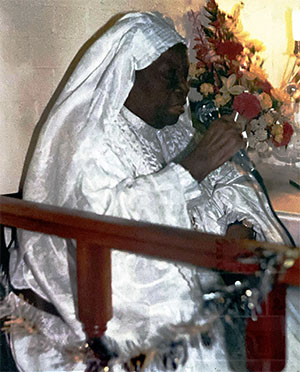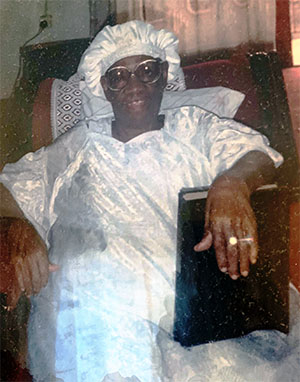Abiodun Emmanuel, Christiana (B)

The Cherubim and Seraphim Movement came into existence through the joint efforts of Moses Orimolade Tunolase and Christianah Abiodun Akinsowon in the year 1925. Moses Orimolade started his ministry as an itinerant evangelist and remained so until his encounter with Abiodun who was a teenage girl at the time. Their collaboration then produced the Cherubim and Seraphim Church.
Christianah Abiodun Emmanuel (née Akinsowon) was born on December 25, 1907 in Abeokuta, Nigeria. Her father, Benjamin Akindele Akinsowon, was a native of Abeokuta while her mother, Elizabeth Smith, came from Port Novo in the Republic of Benin. Abiodun married Mr. George Orisanya Emmanuel on January 29, 1942 and the marriage produced a daughter named Georgiana Yetunde Emmanuel.
Abiodun was around eighteen years old when the Cherubim and Seraphim Society was founded. One day, she had a vision of an angel. Sometime later, she went to witness the annual Catholic celebration of Corpus Christi where she fell into a trance. She was immediately rushed home. Efforts to restore her to normalcy failed until Moses Orimolade was summoned. He succeeded in restoring her. This was the beginning of the relationship between Orimolade and Abiodun that led to the founding of the Cherubim and Seraphim.
Abiodun played a significant role in the Cherubim and Seraphim, right from the start. Her work led to the expansion of the church across major areas in Yorubaland. In the words of J. Akinyele Omoyajowo, “she was the ‘showpiece’ and the most energetic evangelist in the movement. She led various evangelistic groups that established the Society throughout Yorubaland. She earned the title ‘Captain’ by which she has become widely known, after a successful evangelistic tour in 1927.” Speaking further on the issue, he states:
Another factor [for the expansion of the church]—and this was very significant—was the influence of Christanah Abiodun Akinsowon. She has been credited with founding the Society’s branches in most of the important centers in Yorubaland. The leaders demonstrated profound foresight when they sent her with the evangelistic team. In 1927, she was not quite twenty years of age. Her youthfulness and her exceptional beauty, in contrast to the usually strange, poorly clad, unshaven prophets who went about with messages of doom, served as a great attraction to many people, especially youths.
This statement by Omoyajowo describes Abiodun’s position and her contributions to the expansion of the C&S. Abiodun embarked on nationwide evangelistic tours that led to the church’s expansion into the farthest reaches of southwest Nigeria, into neighboring Ghana, the United Kingdom, and the United States. In contrast to Orimolade who concentrated his ministry in and around Lagos, the young and energetic Abiodun and her supporters undertook evangelistic tours into towns in the interior of western Nigeria. She intentionally went beyond Lagos to engage in massive evangelism. Through preaching and miraculous healing, numerous C&S branches were established in major towns such as Ibadan, Abeokuta, Oke Ona, Effon Alaye, Ijebu, Ijesaland, and eventually in the eastern zone of Nigeria. The C&S also spread across the borders of Nigeria into Ghana, the United Kingdom, and the United States.
This expansion was a source of great concern for the mission churches. Omoyajowo inferred that “The sudden feeling of hostility between the mission churches (the Anglican Church in particular) and the C&S came after her evangelistic tours of Yorubaland in 1927, the success of which was practically demonstrated by the pageantry which marked the return to Lagos of the evangelistic party. The C&S then became a suspect.” Geoffrey Parrinder also remarked at the time, “The orthodox churches have grown alarmed at the growth and heterodoxy of the Seraphim.”
Abiodun exercised considerable spiritual impact on the ordinary and important personalities in society. For example, she asserted before the reigning Owa of Ilesha that rain would not fall except by the power of Seraphim and the oba, Owa Obokun, believed her. This shows that Abiodun was recognized within the royal circle of Ijesaland. Omoyajwo recalled that many leading obas of Yorubaland openly supported the C&S. These included the Awujale of Ijebu Ode, Osile of Oke Ona, Alaye of Effon, and Owa of Ijesaland.
Being the first female founder and leader of a church, Abiodun set a precedent for the induction of female religious leadership. As a result, Abiodun served as a catalyst and a symbol of female empowerment, demonstrating the exceptional administrative abilities of women in social and religious matters. Since then, the C&S has encouraged women to engage in the ministry of the church to the full extent of their leadership capacities. Women have, in fact, played outstanding roles in the affairs of the church. Within the society, women are elevated to such high offices as Mother Cherub, Mother Seraph, Captain and Mother in Israel that rank with Apostles and Senior Apostles for men.
However, the church experienced a schism in 1929, four years after its establishment. This led to its fragmentation and a parting of ways between Orimolade and Abiodun. Orimolade died four years later in 1933. Since his death, the leadership of the C&S has passed in succession to many of the prophets of the church, each of whom contributed significantly to its progress in spite of the challenges caused by fragmentation. The continued existence of the church can therefore be attributed to their combined efforts. Through their combined efforts, the church moved to places like Enugu, Onitsha, Aba, Port-Harcourt, Calabar, Owerri, Umuahia, Diobu, Degema, Ahoada, Okrika, Benin, Ishan, Iruekpen, Sapele etc. in the Eastern zone of Nigeria. It also extended across the borders of Nigeria into Ghana, London, and New York.
Captain Christianah Abiodun Akinsowon died in 1994.
Deji Ayegboyin and Michael A. Ogunewu
References:
Ebeye, Boniface. “Abiodun, Emmanuel Christianah.” Https://dacb/org/stories/Nigeria/abiodun-christiana/. Accessed on September 5, 2018.
History of the Eternal Sacred Order of the Cherubim and Seraphim. Http://esocs,net/history/. Accessed on September 6, 2018.
Omoyajowo, J. Akinyele. Cherubim and Seraphim: The History of an African Independent Church. London: NOK Publishers International, 1982.
This article initially appeared in the Journal of African Christian Biography (Oct. 2018) and was subsequently republished on the DACB website.
Photo Gallery






